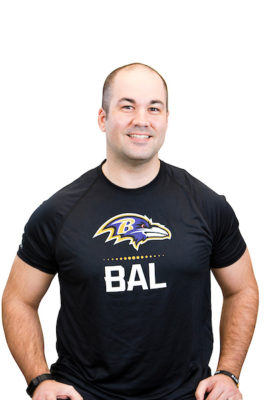
Photo Credit: Baltimore Ravens
Hello, Science Cheerleader fans! As part of NFL Playoff season, we are interviewing some of the current professional cheerleaders who are cheering their teams in the playoffs while also pursuing science, technology, engineering, and math (STEM) careers. Read on to learn more about Chris, a Systems Engineering, Technology, & Innovation (SETI) Program Manager for the Defense Information Systems Agency (DISA) (try saying that quickly!) and a member of the Baltimore Ravens cheerleading and stunt squad.
How did you get interested in engineering?
Before I was a teenager, my Dad (a computer engineer) told me that if I wanted a computer, I had to build one. I welcomed the opportunity and he taught me about every component needed to build a PC from scratch. He taught me how to solder a motherboard; how to source the best RAM; how to install a command line operating system: and how to put the whole system together piece by piece. By learning how something is built, I was able to always think like an engineer, so that if anything ever went wrong, I could break it down and rebuild it. A skill that most engineers find applicable in many of life’s endeavors later on.
Who had the most influence on your career choice?
Richard Clarke—he was a pioneer in cyber. He was thinking about and writing about cyber-related terrorism before anyone else. By reading all of his writings, I became very passionate about public service and using my technical skills to serve our country.
How would you describe what you do?
I started off my career in a very technical field, working throughout college on the National Security Agency (NSA) Scholarship for Service and interning at a different government agency each summer. This allowed me to gain exposure to various jobs and federal agencies, so that when I was ready to finally pick a field to stick with, I had the most information at my disposal. So while I would suggest that all young STEM students start their careers off in the technical arena, I’m now able to use that experience at a management level to acquire state-of-the-art innovations in systems engineering that can benefit our warfighters. It’s my job to work with industry and small businesses around the country to see what amazing new innovations they are coming up with and to then figure out how to bring those innovations into the Department of Defense.
How do you integrate your career with being a professional cheerleader?
Being an engineer in the civil service is all about teamwork, much the same way that cheerleading is. A single engineer cannot accomplish very much on their own. It takes a team to develop a concept or an idea, into compiled code, and then into an operational system. Just like how a single cheerleader cannot do very much on their own, it takes a team to develop a routine or a cheer, to hone that routine, and then to execute it on game day.
What’s your favorite part about your job?
The best part about being in STEM is that it is perfect for people with an insatiable thirst for knowledge. In some fields, all the text books about the entire field are already written. In STEM, you’ll always have more to learn. If you’re a life-long learner, then STEM is for you.
What’s been your best experience as an NFL cheerleader?
Running the American flag out of the tunnel! Standing there in the tunnel, listening to the roar of the crowd, seeing your teammates and the football team behind you, only seeing the smoke in the tunnel in front of you, and then being told to — GO, GO, GO!! No better rush in the world.
What’s one thing people would find surprising about you?
Cheerleading and supporting the military are just my side-gigs. My real job is being a full-time Dad to my two beautiful daughters and husband to my wonderful wife (also my college sweetheart).

